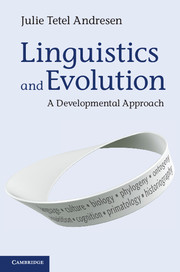Book contents
- Frontmatter
- Contents
- List of Figures
- Introduction Historiography’s contribution to theoretical linguistics
- Part I Theoretical considerations
- 1 Language → languaging
- 2 Developmental systems theory
- 3 A twist in the cognitive turn
- Part II A developmental systems linguistics
- Part III What to do next
- Bibliography
- Name index
- Subject index
2 - Developmental systems theory
Published online by Cambridge University Press: 05 June 2014
- Frontmatter
- Contents
- List of Figures
- Introduction Historiography’s contribution to theoretical linguistics
- Part I Theoretical considerations
- 1 Language → languaging
- 2 Developmental systems theory
- 3 A twist in the cognitive turn
- Part II A developmental systems linguistics
- Part III What to do next
- Bibliography
- Name index
- Subject index
Summary
The shift from language to languaging requires a concomitant shift from a framework where the terms nature and nurture have currency to one where they have been eliminated. The first step in eliminating the nature/nurture dichotomy is to confront the idea of preformationism. This is the theory that every germ cell contains the organism of its kind fully formed and complete in all its parts and that development consists merely in an increase in size from microscopic proportions to those of the adult. Although this theory is now widely discredited, the developmental psychologist Susan Oyama argues convincingly that preformationist thinking is alive and well and has shape-shifted into our ideas about information, the modern source of form. She opens her groundbreaking book The Ontogeny of Information with the passage:
Those who have argued over the origin of ideas and of biological beings have usually agreed that form in some sense preexists its appearance in minds and bodies, though they have disputed the method and time of its imposition. Most solutions to the puzzle of how form arises, therefore, including the most recent biological dogma, have incorporated this assumption. To the extent to which this is true, they are of limited value in answering questions about origins and development. Whether it is God, a vitalistic force or the gene as nature’s agent that is the source of the design of living things and that initiates and directs the unfolding of the design thus matters little to the structure of the argument. Nor are the problems inherent in such a notion lessened by the use of a succession of metaphors, such as genetic plans, knowledge and programs, to serve these cognitive and intentional functions.
(1985: 1)- Type
- Chapter
- Information
- Linguistics and EvolutionA Developmental Approach, pp. 40 - 67Publisher: Cambridge University PressPrint publication year: 2013

